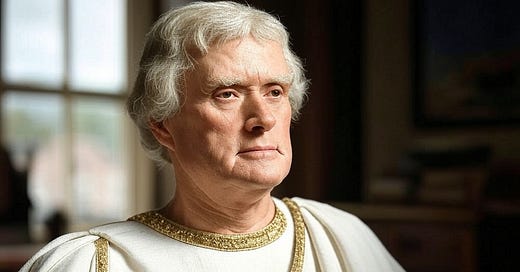Monticello: Portrait of an American Aristo
A brief look into the mind and manor of Thomas Jefferson.
Aristo
Aristocracy is abhorred by modern Americans. Today, the very word smacks of oppression, elitism, and classism, invectives regularly invoked as political subterfuge. This was not the case to the men who made America, or at least gave it mythical expression. In fact, to the Founders, as we fashion them, Aristocracy was something closer to the literal definition in Ancient Greek: Rule (Kratos) of the Excellent (Aristos). Monticello is the architectural legacy and hagiographic ideal of America’s Aristocracy.
The men who made America, or at least gave it mythical expression, were Aristos.
Historic
Monticello (“Little Mountain” in Italian) is one of the most accurate historical depictions of a Southern Plantation anywhere in America. The well-preserved grounds give us profound insight into a self-contained agrarian ecosystem that was bucolic and sophisticated. Jefferson hosted parties and guests (especially James and Dolly Madison), read in his library (his collection is now in the Library of Congress), tinkered in his office, worked in the fields, and presided over a rigid, well defined hierarchy.
Architecture
Jefferson’s home represents a mélange of the trendy European architecture of his day. While the estate went through various reconstructions – perhaps mirroring the intellectual permutations of Jefferson himself – its end state was Greco-Roman in style and Palladian (as in Andrea Palladio) in design. The interior has beds encrusted in walls (French Style), numerous busts and art works of leading figures and historical events, open spaces with natural lighting and narrow stair wells. With the exception of various native American artifacts, Monticello's interior decor is entirely derived from European archetypes, again not unique to him but common to the other Aristos (Hamilton, Washington, Madison etc.) as well.
The Man:
The wide-ranging pursuits of Jefferson’s busy mind are on display as you pace through the estate. Jefferson was a remarkable man, largely because of his energy and all-consuming intellectual pursuits. He was an inventor, agronomist, astronomer, statesmen, philosopher, man of letters, explorer, engineer / architect, and of course the eventual President of the US. Perhaps more interesting, he was an obvious introvert and surprisingly ordinary person (lacking stereotypic charisma or oratorical dynamism). These traits are unquestionably disadvantageous to any public figure today, not then.
He was an inventor, agronomist, astronomer, statesmen, philosopher, man of letters, explorer, engineer / architect, and of course the eventual President of the US.
Contradictory?
It is not controversial to say that Jefferson was also a bit contradictory. The man who penned the Declaration of Independence “did not believe that liberty, equality, and inalienable rights applied to everyone,” writes Kevin Phillips in 1775. This is not the contradiction one might think because no one believed in equality (the way we understand it today) then, nor was that a widely held belief until very recently. However, Jefferson was radically contradictory in one not so subtle way: Property. (Read more here) According to his writings, he did not affirm the right to property, in particular inherited property. This is why he substituted “Pursuit of happiness” for “Property” in the Declaration. Even radicals like Thomas Paine were less convinced on this point. Needless to say, his possessions became him. Jefferson passed Monticello down to his offspring and bankrupted himself beautifying it.
Rivalry
Oscar Wilde said “You can always judge a man by the qualities of his enemies.” For Jefferson this was Alexander Hamilton, and a profoundly capable enemy he was. Hamilton was all the things Jefferson was not, and the reverse is true as well. Hamilton was orphaned (Jefferson was landed gentry), Hamilton spoke French impeccably, and he was a powerful spokesman. “Everything about him was active and outgoing” wrote Gary Wills. Jefferson wrote the Declaration but Hamilton (with Madison) wrote the Federalist, which shaped the Constitution. In short, Jefferson in many ways captures our hearts but Hamilton grips our minds; the progressive versus the realist one might say. As a tip of the cap to his rival, Jefferson kept a bust of Hamilton in his foyer and a self-portrait staring him down.
“You can always judge a man by the qualities of his enemies.”
Oscar Wilde
Feel
Andrea Palladio said that architecture done right should inspire 3 human feelings: calm, harmony, and dignity. These are the feelings that I am left with after visiting Monticello. It is a serene place, not overly grandiose and vain. It is stately without being haughty. It is also distinctly American. Its inner workings and outward design are purposeful, designed to facilitate human actions. Anyone who has traveled to Europe is awe struck by the sheer beauty of its art. Often, that beauty is achieved by sacrificing utility. In Monticello, the two are in harmony the way Palladio intended.
Legacy
Jefferson’s was the age of Aristos. When Washington surrendered command of his Continental Army at the end of the Revolution it was done in salute to Cincinnatus, the Roman hero who saved the Republic and then abdicated his consulship to early retirement as a farmer. Jefferson was melded from the same ember. A nation lives on in the people who inherit the mantle of its founders. One wonders where the Jefferson’s of this world are? Are they hibernating, waiting to be awakened from a deep sleep? We can only hope that like seasonal change they will blossom in the fields once more when the time is ripe and the hunger great.
For more portraits in prose, like and subscribe.










This is excellent, Thomas Jefferson is my favorite founding father. Happy Fourth! 🫡🇺🇸👍 & God Bless! 🙏🏻